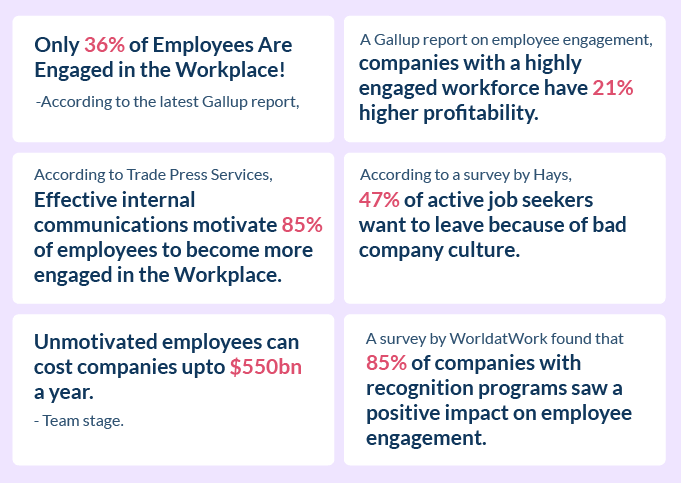Measuring Success:The Magic Of Employee Commitment Surveys
Employee commitment surveys have emerged as powerful tools for organizations seeking to understand the intricacies of their workforce's dedication, motivation, and satisfaction.
Beyond job satisfaction, commitment is a deeper connection that employees feel towards their roles, colleagues, and the company's mission.
In this blog, we'll cover best practices for developing effective commitment surveys and using the data to shape the employee experience positively.
Let's begin!
What is an Employee Commitment Survey?

An employee commitment survey is an assessment tool or survey used by organizations to evaluate or estimate the level of commitment and engagement among their employees. The survey typically includes questions to gather employee feedback regarding their job, work environment, and overall satisfaction. The goal is to understand how employees feel connected to their work, committed to the organization's goals, and motivated to contribute their best efforts.
Types of Commitment

In the 1990s, Allen & Meyerintroduced three types of employee commitment in the Workplace. Recognizing these differences enables you to customize commitment strategies based on the unique needs of various employee groups.
Affective Commitment
Affective commitment reflects an employee's inclination and emotional investment in the organization. This form of commitment profoundly influences performance at both the individual and organizational levels. Those with heightened affective commitment become powerful advocates for your brand, actively engaging others in the talent pool.
Continuance commitment
Continuance commitment centers on employees' assessment of the drawbacks associated with leaving the organization. Rather than relying on a profound emotional connection, it is more rooted in practical considerations.
Normative commitment
Normative commitment is experienced by employees who feel a sense of duty to remain loyal to their organization, deeming it the morally right decision. This commitment may stem from various factors, such as the company's investment in their development, navigating challenging times, or the reliance of their team on their contributions.
Employee Commitment Survey Objectives
An employee commitment survey aims to gather valuable insights into the employee experience, identify areas for improvement, and foster a workplace culture that promotes engagement, satisfaction, and long-term commitment.
The primary objectives of conducting an employee commitment survey include:
- Measure Employee Engagement
- Evaluate Job Satisfaction
- Identify Drivers of Commitment
- Assess Organizational Culture
- Measure Perceived Support
- Informed Strategic Decision-Making
- Identifying Areas of Improvement
- Enhancing Workplace Morale
- Reducing Turnover
- Recognizing and Rewarding Employees
Acknowledge and reward employees for their contributions. Understanding what aspects of work are valued by employees allows organizations to tailor recognition and reward recognition and reward programs effectively.
Employee Commitment Survey Benefits
Employee surveys provide metric-driven insights to maintain an engaged, fulfilled workforce, supporting retention, productivity, and business results. The data supports effective decision-making and culture initiatives.
Here are some of the key benefits of conducting employee commitment surveys:
Employee Engagement: The Commitment Surveys are instrumental in providing insights into the level of employee engagement and commitment. Understanding these factors can help organizations create strategies to enhance engagement.
Identifying Areas for Improvement: The survey findings are valuable for organizations seeking to make targeted improvements in leadership, communication, or workplace culture.
Cultural Alignment: Surveys help assess whether employees align with the organization's values and mission. Understanding cultural alignment can guide efforts to reinforce and promote the desired organizational culture.
Data-Driven Decision Making: Employee commitment survey results provide data that can inform decision-making processes. This data-driven approach allows organizations to prioritize initiatives based on their workforce's actual needs and concerns.
Retention risks: By analyzing survey data, you can predict which employees are at high risk of leaving, so proactive retention measures can be taken. This helps reduce turnover costs.
Competitive analysis & Track trends. Conducting periodic surveys allows you to benchmark results against past surveys to track trends. Improving or declining trends indicate whether workplace interventions and programs are working. Employee satisfaction data can be compared with industry benchmarks to evaluate how your organization fares against competitors and best workplace program criteria. This signals areas requiring priority focus.
Read about Easy Ways To Influence Strong Organizational Commitment here.
Key Statistics

20 Employee Commitment Survey Questions You Should Ask At Work

There is no set rule for how many employee commitment survey questions you should ask, but here are some general guidelines:
Keep the survey focused but comprehensive. You want to cover all the major factors influencing employee commitment and engagement but not make the survey overly long. The ideal number to aim for is 5-30 questions.
Here is a list of 20 Employee commitment survey questions you can ask-
-
Rate your commitment to your job on a scale of 1 to 5.
-
On a scale of 1 to 5, how likely are you to recommend our organization as a great workplace?
-
Share your agreement level: "I feel an emotional connection to the company's values and mission."
-
On a scale of 1 to 5, how supported do you feel by your manager/supervisor day-to-day?
-
Rate your understanding of the long-term goals and vision of the business on a scale of 1 to 5.
-
Rate your current role and responsibilities on a scale of 1 to 5.
-
Do you believe there are opportunities for professional growth and advancement?
-
How would you rate your work-life balance in this organization?
-
On a scale of 1 to 5, do you feel a sense of teamwork and collaboration within your department?
-
Rate your confidence in the leadership and direction provided by management on a scale of 1 to 5.
-
How well do you think information is communicated within the organization?
-
Rate your happiness with the benefits and perks offered by the company on a scale of 1 to 5.
-
Do you feel adequately recognized and rewarded for your contributions?
-
How much independence and autonomy do you have over how you do your work
-
On a scale of 1 to 5, how diverse and inclusive do you perceive our company to be?
-
Are you satisfied with the feedback and performance evaluation processes?
-
To what extent do you feel the organization's values align with yours?
-
Is there anything else you'd like to share regarding your commitment to the company?
-
How can the company enhance its commitment to inclusivity and diversity?
-
Any suggestions for improving employee commitment at our organization?
Recommended Resource: To get a comprehensive list of questions, you can refer to our blog on55 Essential Employee Pulse Survey Questions For 2024
How to Craft High-Impact Employee Commitment Surveys

Designing questions effectively is essential when creating a survey to gauge employee commitment successfully. It's important to comprehend your Workplace's distinct values, priorities, and dynamics to customize the survey to match your organization's culture.
To craft surveys that truly make a difference, follow these key steps:
Define Objectives: Clearly outline survey goals, such as measuring satisfaction or identifying improvement areas.
Understand Culture: Grasp your organization's values and dynamics to tailor questions effectively.
Use a Mix of Question Types: Incorporate a variety of question types, including multiple-choice, open-ended, Likert scale, and ranking questions. This diversity provides a more comprehensive view of employee sentiments.
Focus on Key Drivers: Identify your organization's key drivers of employee commitment. Tailor questions to address these specific factors, such as leadership, communication, work-life balance, and career development.
Maintain Survey Length: Respect time by keeping the survey short, increasing response rates and engagement.
Ensure Anonymity: Emphasize confidentiality to encourage honest feedback on sensitive topics.
Pilot Test: Test the survey with a small group to ensure all issues are resolved before full deployment.
Benchmark Results: Comparing results against industry standards gives context to interpreting the data and helps identify areas where your organization excels or needs improvement.
Follow-Up and Action Plans: Communicate the findings transparently to employees after collecting and analyzing survey responses. Establish an action plan to address identified issues and celebrate successes. This demonstrates a commitment to addressing concerns and improving the work environment.
Following these steps ensures your surveys are effective and actionable and enhances employee satisfaction and engagement.
Read our blog10 Practical Ways To Improve Employee Commitment In Your Organization, to learn more about ways to enhance organizational commitment in order to engage and align your employees to inspire success.
Question Design Principles, Tailoring Surveys to Organizational Culture
Creating effective surveys relies on clear and simple question design principles. Prioritize clarity to directly contribute to survey objectives, using various question types to understand employee sentiments completely.
Maintain a balanced, neutral tone to avoid bias and include actionable questions for meaningful insights. When tailoring surveys to organizational culture, align questions with core values, customize language, and respect diverse perspectives.
Highlight strengths, involve employees in the design, and regularly update questions to adapt to evolving cultures. Transparent communication about the survey's connection to organizational culture builds trust and enhances overall survey effectiveness.
Several survey tools tailor the surveys to cater to specific audiences.
For instance, Vantage Pulse provides 25+ diverse pre-built survey templates, each designed for specific aspects of the employee experience.
Employee Engagement Metrics and Their Interpretation
Employee engagement metrics are key indicators that organizations use to measure their workforce's commitment, satisfaction, and overall well-being. Interpreting these metrics provides valuable insights into the organization's health and helps identify areas for improvement. A thorough analysis gives us a complete picture of how well the organization is doing and if its plans to make the Workplace positive and engaging are working. Checking regularly helps the organization find and fix problems early, making employees happier and more committed.
Here are the top 10 employee engagement metrics and their interpretation:
Employee Net Promoter Score (eNPS):
Metric: Measures the likelihood of employees recommending the organization as a good workplace.
Interpretation: A high eNPS suggests positive employee advocacy, indicating that employees are satisfied and likely to promote the organization to others.
Employee Satisfaction Score (ESS):
Metric: Captures overall employee satisfaction through surveys or assessments.
Interpretation: A high ESS indicates that employees are content with their work, while a low score may signal dissatisfaction and potential retention issues.
Retention Rate:
Metric: Measures the percentage of employees retained over a specific period.
Interpretation: A high retention rate is a positive sign of employee commitment, while a declining rate may indicate dissatisfaction, lack of growth opportunities, or poor work culture.
Absenteeism Rate:
Metric: Measures the percentage of scheduled work hours that employees miss.
Interpretation: A low absenteeism rate generally indicates a motivated and engaged workforce, while a high rate may suggest disengagement or burnout.
Employee Productivity:
Metric: Measures the efficiency and output of individual employees or teams.
Interpretation: Increased productivity often correlates with high engagement, while declining productivity may signal disengagement or work efficiency issues.
Employee Recognition and Feedback:
Metric: Measures the frequency and quality of employee recognition and feedback.
Interpretation: Regular positive recognition and constructive feedback contribute to high engagement, job satisfaction, and motivation.
Participation in Training and Development:
Metric: Tracks employee participation in training and professional development programs.
Interpretation: High participation rates indicate a commitment to growth and development, while low participation may signal disinterest or a lack of investment in employee skills.
Employee Surveys:
Metric: Collects feedback on the work environment, leadership, and overall job satisfaction.
Interpretation: Analysis of survey results provides detailed insights into specific areas of strength and areas needing improvement.
Peer Recognition and Collaboration:
Metric: Measures the level of collaboration and peer recognition within the organization.
Interpretation: A positive culture of collaboration and peer recognition fosters engagement, while a lack of collaboration may lead to isolation and disengagement.
Growth and Advancement Opportunities:
Metric: Evaluate the organization's availability and perception of career growth opportunities.
Interpretation: A positive outlook on growth opportunities contributes to higher engagement, while a perception of limited career advancement may lead to dissatisfaction.
Understanding affective and continuance commitment, implementing benchmarking practices, and tracking progress are crucial in managing employee commitment and organizational success.
Balancing affective and continuance commitment metrics keeps engagement initiatives grounded in emotional connections and shared values while addressing practical needs and barriers. Interpreting results requires identifying root causes, not just symptoms, through statistical analysis techniques exploring interrelated impacts.
Organizations that invest in understanding these metrics can tailor their strategies to enhance employee commitment, satisfaction, and overall well-being, ultimately contributing to a positive and productive work environment.
Survey Templates: Customization and Implementation

Adapting Templates for Specific Needs, Ensuring Effective Deployment
Creating effective survey templates involves careful customization and thoughtful implementation to gather relevant and actionable participant insights. Here's a guide on customizing and implementing survey templates:
Define Objectives:
Clearly outline the survey's purpose and objectives. Know what information you seek to gather and the desired outcomes.
Identify Key Themes:
Determine the main themes or topics you want to explore. These could include employee satisfaction, work environment, communication, leadership, or specific projects.
Tailor Questions to Objectives:
Craft questions that directly align with your survey objectives. Ensure clarity and relevance to elicit meaningful responses.
Include a Mix of Question Types:
Use a variety of question types, such as multiple-choice and open-ended questions. This provides both quantitative and qualitative data.
Consider the Employee Experience:
Put yourself in the shoes of the employees. Ensure questions are relatable and considerate of their experiences in the Workplace.
Maintain Survey Length:
Keep the survey concise to prevent survey fatigue. Balance depth with brevity to encourage higher participation.
Select a Survey Tool:
Choose a survey tool that aligns with your customization needs and is user-friendly for administrators and participants. Popular options include SurveyMonkey, Google Forms, or specialized HR software like Culture Moneky, Hive HR, etc.
Feedback and Action Plan:
Communicate survey results transparently with participants. Communicate the purpose and importance of the survey to participants. Emphasize the anonymity of responses to encourage honest feedback. Develop an action plan based on the feedback received, demonstrating a commitment to addressing concerns and improving.
To get kickstarted, here are the Top Employee Pulse Survey Tools
By customizing your survey template with care and implementing it thoughtfully, you can gather valuable insights from your workforce, fostering a culture of continuous improvement and employee engagement within the organization.
Here is a template for reference:
Employee Commitment Survey
Introduction:
Thank you for taking the time to participate in our Employee Commitment Survey. Your honest feedback is invaluable in helping us create a workplace that fosters commitment, satisfaction, and success.
Section 1: Demographics
1.1. Department/Team:
- Administration
- Sales
- Marketing
- Operations
- Finance
- Human Resources
- Other (please specify)
1.2. Years with the Company:
- Less than 1 year
- 1-2 years
- 3-5 years
- 6-10 years
- More than 10 years
Section 2: Overall Commitment
2.1. On a scale of 1 to 5, how committed do you feel to the organization's success?
- 1 (Not at all committed)
- 2
- 3
- 4
- 5 (Extremely committed)
Section 3: Job Satisfaction
3.1. How satisfied are you with your current role and responsibilities?
- Very Dissatisfied
- Dissatisfied
- Neutral
- Satisfied
- Very Satisfied
3.2. What aspects of your job contribute most to your job satisfaction? (Open-ended)
Section 4: Communication
4.1. How satisfied are you with the communication channels within the organization?
- Very Dissatisfied
- Dissatisfied
- Neutral
- Satisfied
- Very Satisfied
4.2. What suggestions do you have for improving communication within the organization? (Open-ended)
Section 5: Leadership Effectiveness
5.1. How would you rate the effectiveness of your immediate supervisor/manager?
- Ineffective
- Somewhat Ineffective
- Neutral
- Effective
- Very Effective
5.2. How could your supervisor/manager enhance your commitment and satisfaction? (Open-ended)
Section 6: Career Development
6.1. Are there sufficient opportunities for career development within the organization?
- Strongly Disagree
- Disagree
- Neutral
- Agree
- Strongly Agree
6.2. What specific areas of career development would you like to see improved or expanded? (Open-ended)
Section 7: Additional Comments
7.1. Do you want to share anything about your commitment to the organization? (Open-ended)
Conclusion:
Thank you for completing our Employee Commitment Survey. Your feedback is crucial in shaping the future of our organization.
Decoding Survey Data: Methods and Implications
Advanced Analytical Techniques, Transforming Data into Actionable Strategies
Decoding survey data involves employing various methods to analyze and understand the collected information, with implications that can guide strategic decision-making.
Below are the key steps and considerations to follow for the process :
Quantitative Analysis:
Utilize statistical methods to analyze numerical data; this provides a quantitative overview of survey responses, highlighting trends and patterns.
Comparative Analysis:
Comparative analysis involves comparing different groups or segments within the dataset. This could include comparing responses based on demographics, departments, or other relevant factors, offering insights into variations and trends.
Correlation and Regression Analysis:
Correlation analysis explores relationships between different survey variables, revealing patterns of association. It helps identify connections and dependencies, revealing which factors may influence others.
Qualitative Analysis:
In addition to quantitative methods, qualitative analysis involves examining open-ended responses and comments. Thematic coding and content analysis help uncover themes, sentiments, and specific insights that may not be captured through numerical data alone.
Benchmarking:
Benchmarking involves comparing survey results to external standards or previous internal benchmarks. This contextualization helps organizations understand how their performance compares to industry norms or historical data.
Implications for Decision-Making:
The implications drawn from survey data analysis guide decision-making processes. Identified patterns, trends, and key findings inform strategies for organizational improvement, whether in terms of employee engagement, customer satisfaction, or other survey objectives.
Actionable Recommendations:
The ultimate goal of decoding survey data is to generate actionable recommendations. These recommendations are based on the insights gained from the analysis and are designed to drive positive changes within the organization.
Monitoring:
Decoding survey data is not a one-time process; it involves continuous monitoring and iterative analysis. Regular surveys and reviews ensure that organizations stay informed about evolving trends and can adapt strategies accordingly.
How Can An Employee Survey Tool Help You Measure Employee Commitment At Your Organization?

Thoughtfully designed surveys provide insights into how connected employees feel to the company mission, their level of motivation, and potential trouble spots impacting retention. The findings allow leadership to craft targeted interventions that nurture engagement, belonging, and purpose.
The right employee survey partner offers validated methods yet adaptable operational features, ensuring effortless, engaging, and impactful executions that promote a listening culture.
Numerous employee survey tools offer unique features and functionalities to help organizations gather feedback, measure engagement, and assess employee sentiments.
Survey platforms such as Vantage Pulse, Survey Monkey, Culture Monkey, Peakon, etc., offer a user-friendly interface compatible with various devices and platforms, ensuring employees can conveniently take the survey at their own pace.
Regularly employing an employee survey tool to gather feedback from employees through surveys enables organizations to make well-informed decisions.
Several companies are known for prioritizing employee commitment through surveys, for eg.-
IBM Checkpoint
With IBM transitioning towards new areas like cognitive, cloud computing, and big data, it required that they have an agile and mobile performance system that helps people develop short-term goals and facilitates regular feedback. IBM Checkpoint involves continuous feedback throughout the year. It leverages the five dimensions as the basis for feedback throughout the year and for the final rating assessment of the employee.
Cisco Engagement Pulse Survey
Cisco's Engagement Pulse survey was designed to gauge how effectively leaders engage their teams. These items measure the levers that a team leader can influence. This allows Cisco to stay on top of employees' feelings and single out areas for improvement.
Conclusion
Conducting an employee commitment survey is a valuable initiative for organizations seeking to enhance workplace engagement and productivity. The insights from such surveys provide a comprehensive understanding of employees' sentiments, allowing employers to address concerns, strengthen organizational culture, and foster a more committed workforce. By actively listening to employees and implementing meaningful changes, businesses can create an environment that promotes loyalty, satisfaction, and success.


















